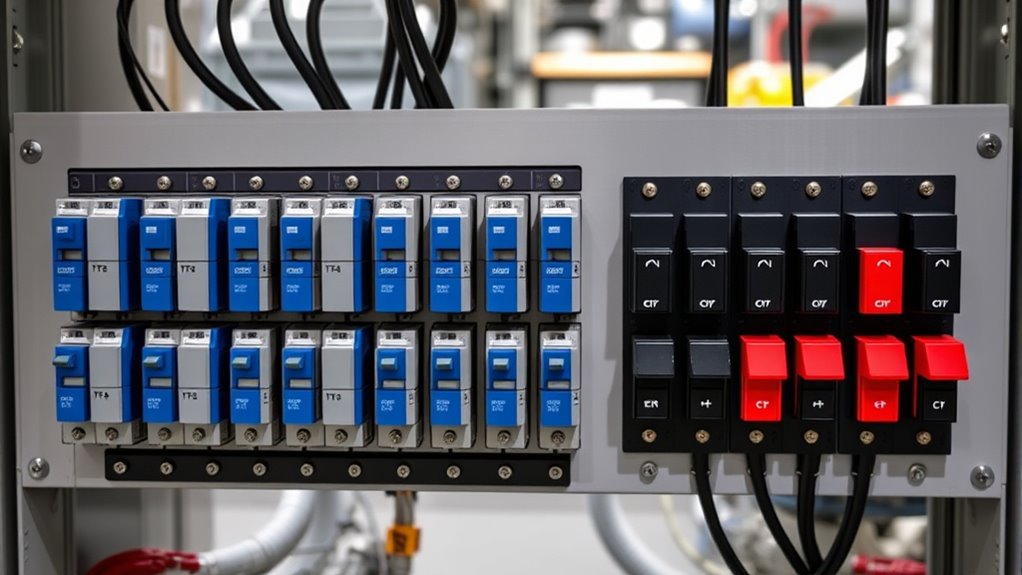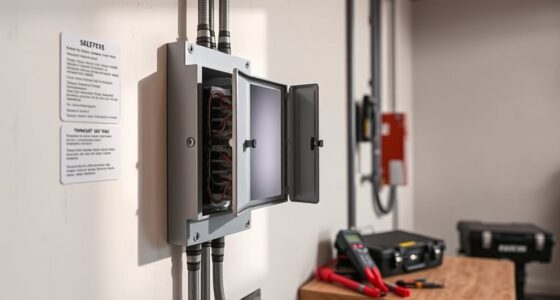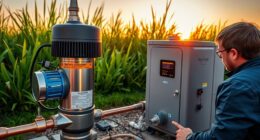When choosing an automatic transfer switch, do prioritize compatibility with your generator’s specifications, load capacity, and safety features like proper grounding. Avoid rushing installation, skipping manufacturer instructions, or ignoring ventilation needs. Do check for correct wiring and test systems regularly to prevent malfunctions. Keeping these do’s and don’ts in mind guarantees safe, reliable operation. For detailed tips on selecting, installing, and maintaining your ATS, keep exploring to make the best choice.
Key Takeaways
- Do verify compatibility with your generator’s voltage, phase, and power output before installation.
- Not do overlook load capacity; ensure the switch can handle your total connected load safely.
- Do test transfer times to match your operational needs and confirm seamless power switching.
- Not do ignore manufacturer instructions or skip proper grounding procedures during setup.
- Do schedule regular maintenance and inspections to detect wiring issues, clean components, and ensure safety.
Understanding Different Types of Automatic Transfer Switches
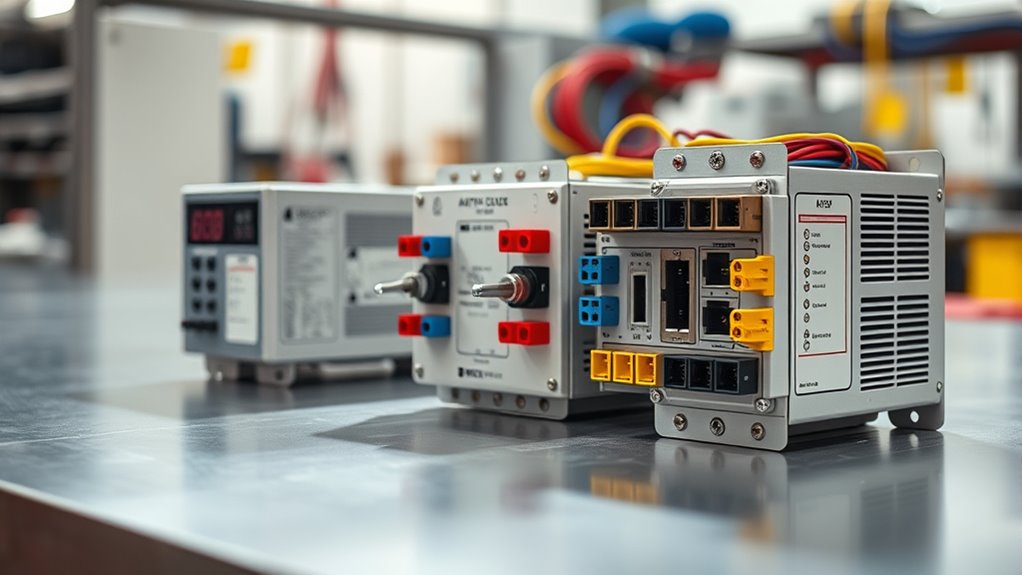
To effectively choose the right automatic transfer switch (ATS) for your needs, it’s important to understand the different types available. There are several ATS options tailored to various generator options and operational needs. Manual transfer switches require you to activate them during power outages, offering simplicity but less convenience. Automatic switches detect power loss and switch seamlessly, providing continuous safety precautions. Some models are rated for residential use, while others suit commercial applications. Consider your generator’s capacity and compatibility when selecting an ATS type. Safety precautions include ensuring proper grounding and regular maintenance to prevent faults. Knowing the distinctions among these types helps you pick the right solution, ensuring reliable power transfer and safety for your setup. Additionally, understanding ventilation considerations can improve your system’s reliability and safety in enclosed spaces.
Key Features to Prioritize When Selecting an ATS
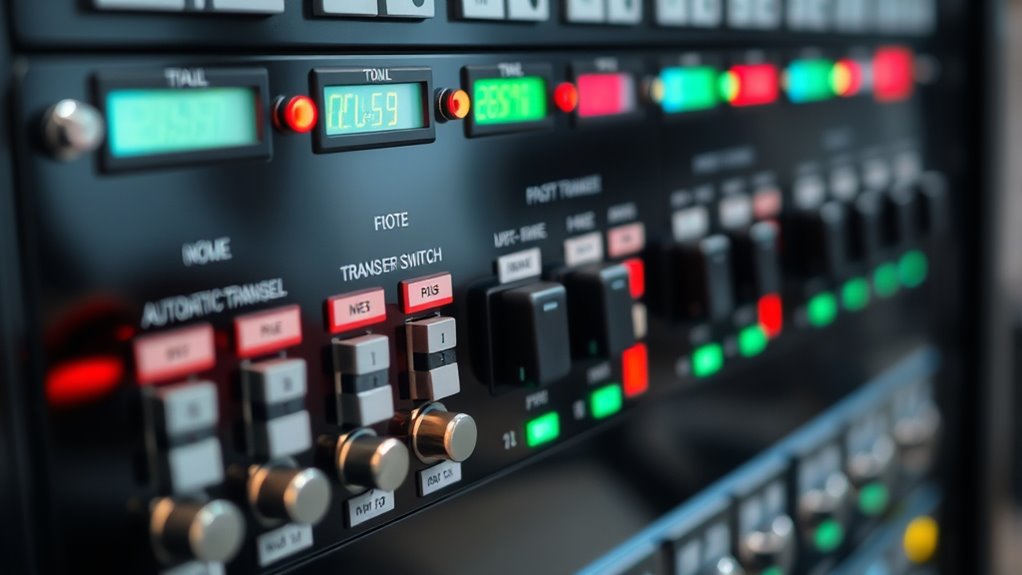
When selecting an automatic transfer switch (ATS), prioritizing key features guarantees you get a reliable and safe system tailored to your needs. First, verify the ATS is compatible with your generator’s specifications, including voltage, phase, and power output. Generator compatibility is essential for seamless operation during power outages. Next, evaluate the load capacity; it must handle your total connected load without overloading. An ATS with appropriate load capacity ensures your critical systems stay powered without interruptions or damage. Additionally, consider features like transfer time, ease of installation, and built-in safety mechanisms. These factors collectively ensure your ATS delivers dependable performance, safeguards your equipment, and maintains continuous power supply when you need it most. Incorporating well-being tips can also help maintain overall system performance and safety.
Common Mistakes to Avoid During Installation and Setup
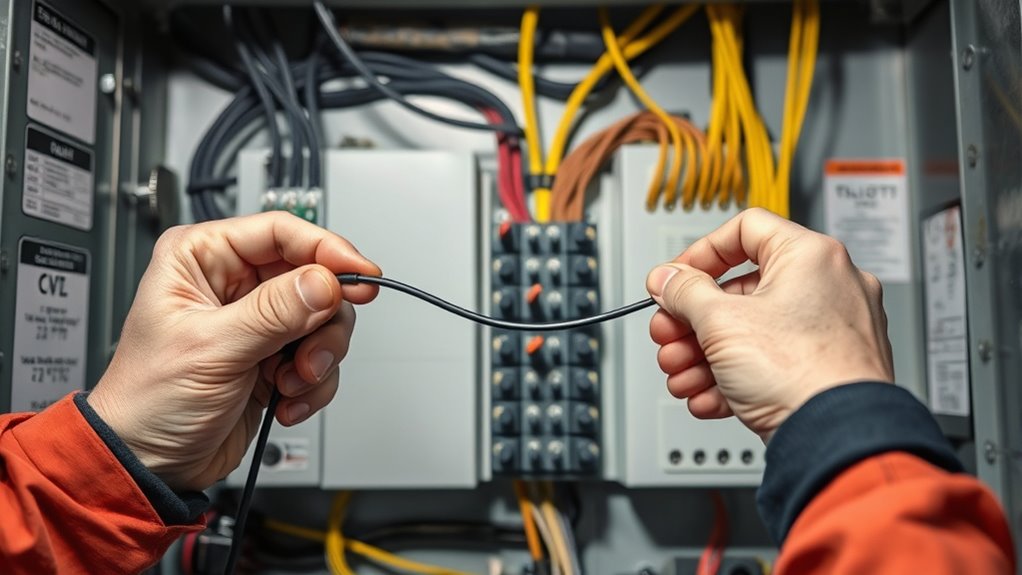
Proper installation and setup of your automatic transfer switch can prevent costly mistakes and guarantee reliable operation. Common installation pitfalls include wiring mistakes, incorrect grounding, or overlooking manufacturer instructions. These setup errors can lead to switch failure, safety hazards, or system downtime. Avoid rushing through the process; carefully read all instructions and double-check connections before powering up. Verify that the transfer switch is compatible with your generator and electrical system. Misjudging load capacity or misplacing control components can cause malfunction. Properly labeling wiring and testing the system after installation are essential steps. Additionally, understanding hydrogen safety protocols and implementing appropriate detection systems can further ensure safe operation. By paying close attention to detail and following best practices, you can avoid installation pitfalls and setup errors, ensuring your transfer switch operates efficiently and safely when you need it most.
Tips for Maintaining and Troubleshooting Your Transfer Switch

Regular maintenance and troubleshooting are essential to keep your transfer switch functioning reliably when you need it most. Establish regular maintenance routines, such as inspecting connections, testing alarm signals, and cleaning components to prevent dirt buildup. Use troubleshooting techniques like checking for loose wires, verifying power supplies, and testing the switch’s operation during a manual transfer. Keep detailed records of maintenance activities and any issues you encounter to identify patterns or recurring problems. If you notice irregularities or the switch doesn’t operate correctly, don’t delay—address problems promptly to avoid system failure during an outage. Performing routine checks and applying effective troubleshooting techniques ensures your transfer switch stays in peak condition, providing peace of mind during power disruptions. Additionally, understanding the different transfer switch types can help you select and maintain the most suitable system for your needs.
Frequently Asked Questions
How Often Should I Test My Automatic Transfer Switch?
You should test your automatic transfer switch at least once a month to guarantee reliable backup power. Regular generator maintenance includes these tests to catch any issues early. By doing so, you guarantee your backup power system works when needed, preventing unexpected failures. Monthly testing helps confirm the transfer switch’s proper operation, giving you peace of mind during outages and keeping your generator ready for any emergency.
Can an ATS Be Integrated With Renewable Energy Systems?
Imagine a seamless dance between your energy sources. Yes, an ATS can be integrated with renewable energy systems, enhancing solar integration and energy storage. This setup allows your system to switch smoothly between grid power and renewable sources, ensuring reliable backup and efficiency. With proper configuration, your ATS adapts effortlessly to the fluctuating nature of renewable energy, giving you peace of mind and a greener, more resilient energy solution.
What Certifications Should I Look for in an ATS?
You should look for an ATS certified to recognized certification standards like UL 1008 or IEC 60947-6-1, ensuring it meets safety regulations. These certifications guarantee the switch’s reliability and safety during power handovers. Always verify that the ATS complies with local electrical codes and standards to prevent hazards. Choosing a certified ATS not only safeguards your equipment but also provides peace of mind knowing it’s tested for performance and safety.
How Does Load Capacity Impact ATS Choice?
Your load capacity directly affects your ATS choice, as it must handle your load calculations accurately. If your equipment demands a higher load capacity, you need a switch rated for that load to prevent overloads and ensure smooth operation. Always verify compatibility with your equipment’s electrical requirements. Choosing an ATS with insufficient load capacity risks failure, while oversizing can be inefficient and costly.
Are There Wireless Options for Automatic Transfer Switches?
Did you know that over 30% of modern ATS options now include wireless connectivity? Yes, there are wireless automatic transfer switches available today. These models enable remote monitoring and control, allowing you to oversee your system from anywhere. Wireless options enhance convenience, reduce wiring complexity, and improve response times during power fluctuations. So, if you’re seeking flexibility and advanced features, look for ATS with wireless connectivity for seamless, remote management.
Conclusion
Choosing the right automatic transfer switch isn’t just about ticking boxes; it’s about ensuring peace of mind when you need it most. By understanding the types, prioritizing key features, and avoiding common pitfalls, you set yourself up for smooth operation. With proper maintenance and attentive troubleshooting, your ATS can quietly serve as a dependable guardian. Remember, a little care now can keep unexpected surprises at bay, letting you focus on what truly matters.
